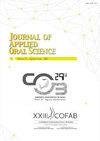Titanium micro-nano textured surface with strontium incorporation improves osseointegration: an in vivo and in vitro study.
IF 2.6
3区 医学
Q2 DENTISTRY, ORAL SURGERY & MEDICINE
引用次数: 0
Abstract
OBJECTIVES This study aimed to investigate the osseointegration of titanium (Ti) implants with micro-nano textured surfaces functionalized with strontium additions (Sr) in a pre-clinical rat tibia model. METHODOLOGY Ti commercially pure (cp-Ti) implants were installed bilaterally in the tibia of 64 Holtzman rats, divided into four experimental groups (n=16/group): (1) Machined surface - control (C); (2) Micro-nano textured surface treatment (MN); (3) Micro-nano textured surface with Sr2+ addition (MNSr); and (4) Micro-nano textured surface with a higher complementary addition of Sr2+ (MNSr+). In total, two experimental euthanasia periods were assessed at 15 and 45 days (n=8/period). The tibia was subjected to micro-computed tomography (μ-CT), histomorphometry with the EXAKT system, removal torque (TR) testing, and gene expression analysis by PCR-Array of 84 osteogenic markers. Gene expression and protein production of bone markers were performed in an in vitro model with MC3T3-E1 cells. The surface characteristics of the implants were evaluated by scanning electron microscopy (SEM), energy-dispersive spectroscopy (EDS), and laser scanning confocal microscopy. RESULTS SEM, confocal, and EDS analyses demonstrated the formation of uniform micro-nano textured surfaces in the MN group and Sr addition in the MNSr and MNSr+ groups. TR test indicated greater osseointegration in the 45-day period for treated surfaces. Histological analysis highlighted the benefits of the treatments, especially in cortical bone, in which an increase in bone-implant contact was found in groups MN (15 days) and MNSr (45 days) compared to the control group. Gene expression analysis of osteogenic activity markers showed modulation of various osteogenesis-related genes. According to the in vitro model, RT-qPCR and ELISA demonstrated that the treatments favored gene expression and production of osteoblastic differentiation markers. CONCLUSIONS Micro-nano textured surface and Sr addition can effectively improve and accelerate implant osseointegration and is, therefore, an attractive approach to modifying titanium implant surfaces with significant potential in clinical practice.掺入锶的钛微纳米纹理表面可改善骨结合:一项体内和体外研究。
目的:本研究旨在研究在临床前大鼠胫骨模型中,表面具有添加锶(Sr)功能的微纳米纹理钛(Ti)植入物的骨结合情况。方法将商业纯钛(cp-Ti)植入物双侧安装在 64 只 Holtzman 大鼠的胫骨上,分为四个实验组(n=16/组):(1)机加工表面-对照组(C);(2)微纳米纹理表面处理组(MN);(3)添加 Sr2+ 的微纳米纹理表面处理组(MNSr);(4)添加更多 Sr2+ 的微纳米纹理表面处理组(MNSr+)。共评估了两个实验安乐死期,分别为 15 天和 45 天(n=8/期)。对胫骨进行了微型计算机断层扫描(μ-CT)、EXAKT系统组织形态测量、移除扭矩(TR)测试,并通过PCR-Array对84种成骨细胞标记物进行了基因表达分析。在 MC3T3-E1 细胞的体外模型中进行了骨标记的基因表达和蛋白质生成。通过扫描电子显微镜(SEM)、能量色散光谱(EDS)和激光扫描共聚焦显微镜对植入物的表面特征进行了评估。结果SEM、共聚焦和 EDS 分析表明,MN 组形成了均匀的微纳米纹理表面,而 MNSr 和 MNSr+ 组则添加了 Sr。TR 测试表明,经过处理的表面在 45 天内的骨结合率更高。组织学分析凸显了处理方法的优势,尤其是在皮质骨方面,与对照组相比,MN 组(15 天)和 MNSr 组(45 天)的骨-种植体接触增加。成骨活性标志物的基因表达分析表明,各种与成骨相关的基因都发生了改变。根据体外模型,RT-qPCR 和 ELISA 显示,处理有利于成骨细胞分化标志物的基因表达和产生。
本文章由计算机程序翻译,如有差异,请以英文原文为准。
求助全文
约1分钟内获得全文
求助全文
来源期刊

Journal of Applied Oral Science
医学-牙科与口腔外科
CiteScore
4.80
自引率
3.70%
发文量
46
审稿时长
4-8 weeks
期刊介绍:
The Journal of Applied Oral Science is committed in publishing the scientific and technologic advances achieved by the dental community, according to the quality indicators and peer reviewed material, with the objective of assuring its acceptability at the local, regional, national and international levels. The primary goal of The Journal of Applied Oral Science is to publish the outcomes of original investigations as well as invited case reports and invited reviews in the field of Dentistry and related areas.
 求助内容:
求助内容: 应助结果提醒方式:
应助结果提醒方式:


